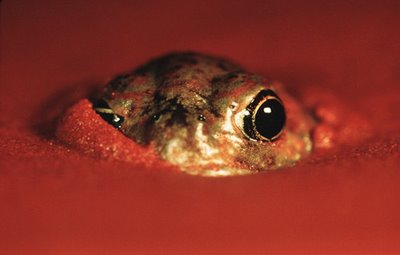Hopes are high for the Baltimore Symphony and Marin Alsop, the first woman to be appointed Music Director of a major American orchestra. Last night at Strathmore, Washington got a taste of adventurous programming we may expect from Alsop, who has made a name conducting contemporary music, especially by American composers. In a brief introduction to this program devoted to the music of Philip Glass, born in Baltimore 70 years ago this year, Alsop made no reference to the embarrassing neglect of Glass in Baltimore for so many years. That era, she said by gracefully not saying anything, is over. To put that neglect into context, the BSO is the only major ensemble in the Washington and Baltimore area to acknowledge Glass's 70th birthday.
LIFE: A Journey through Time began when nature photographer
Frans Lanting, whose work is probably familiar from many appearances in
National Geographic and other publications, saw a way to document the history of life on Earth, by looking closely at life right now. (A
coffee-table book is now available, and an
exhibit will begin touring the United States this year.) Together with visual choreographer Alexander V. Nicholas, Lanting organized a selection of his photographs into a video narrative. With the guidance of Marin Alsop, the project was brought to
Philip Glass to provide a musical score, first performed last summer at the
Cabrillo Festival, the contemporary music festival that Alsop directs. In tandem with Michael Riesman, who often conducts and orchestrates Glass's music, Glass adapted several earlier works, conceived originally for small ensemble or solo instruments, for orchestra.
Glass's music works best when it accompanies visual images, which is why he is such a good film and opera composer. Some of Glass's most memorable music accompanied the striking films by Godfrey Reggio, especially the first one,
Koyaanisqatsi, from 1983. His latest film score, for
Notes on a Scandal, is up for an Oscar and deserves to win, because it is such an important part of that movie. (In fact, because Glass is in Los Angeles this weekend for the Academy Award ceremony, he could not attend this series of concerts.)

Photograph by Frans Lanting, courtesy of National Geographic |
Over the course of seven movements, detailing the story of creation, not according to Genesis but following the course of evolution as narrated by science, Glass's music accompanies the formation of the earth and its atmosphere; the beginning of life shown in fossilized remains of tiny creatures, crystals, and amber; the movement of animals in the sea; the movement of amphibians out of the water (with some of the most memorable images in the video, of frogs peering out of the slime toward land); the rise of tortoises and crocodiles, birds in the air, mammals, apes, and finally a few glimpses of our own species, but only as a fetus in utero. The video, projected on three large screens suspended above the orchestra, sets many of Lanting's images into motion, kangaroos bouncing along, birds soaring upward diagonally, multiple flowers tesselating furiously along with the bubbling music.
The score is everything one expects of Philip Glass, static, pulsating, and hypnotically pleasing to the ear. It occurred to me last night that Glass is the modern counterpart of Antonio Vivaldi, whose music was played with such verve and polish by the
Venice Baroque Orchestra in a magnificent concert earlier in the week. Glass's music appeals widely, is mostly programmatic and rhythmically activated, trades on formulas in easy-to-understand forms, and is characterized by a high degree of self-borrowing. What is most evident in
LIFE is just how important Michael Riesman's orchestration is to Glass's success: the underlying ideas are so simple, but Riesman's layering of instrumental colors dresses it all up considerably.

Photograph by Frans Lanting, courtesy of Baltimore Symphony |
Marin Alsop did a good job of sculpting the masses of sound: without that dynamic and textural shaping there would not be much interest. Since its premiere, the video has undergone some significant changes for this set of concerts, its East Coast premiere, as Alsop explained during a question and answer session after last night's performance. Once the video has been started, the performance relies on Alsop's conducting to time the music so that it lines up with the sequence of images. The orchestra offered sounds from glassy to hysteric, with especially nice work on those trademarked whirring Glass arpeggios, which one could hear the woodwind players rehearsing at intermission.
The program began with one of Glass's most often performed pieces, the
Concerto for Saxophone Quartet, a piece featuring "instruments we normally try to keep out of the orchestra," as Alsop joked. The
Capitol Quartet lent its suave tone and agile fingers to a fine performance, with minor lags behind the orchestra, which Alsop turned occasionally to correct with her gestures. This jazz-inflected work, combined with the BSO's "Casual Thursday" dressed-down look -- black shirts with open collars, black slacks -- contributed to the impression that we were at a hipper kind of Pops concert. Glass's appeal outside the classical realm meant that the audience was considerably less gray of hair than normal (that may account for the applause that broke out after each movement of the concerto, too). Brava, maestra! We look forward to more of the same.
This program will be repeated on Friday and Saturday evenings (February 23 and 24, 8 pm) and Sunday afternoon (February 25, 3 pm), but only at Meyerhoff Symphony Hall in Baltimore. Plenty of tickets remain. Frans Lanting will speak about his LIFE photographs on Tuesday (February 27, 7:30 pm) at National Geographic Society headquarters (1600 M St. NW)





















































2 comments:
Frans Lanting will discuss the photographs in his project "Life: A Journey Through Time," Tuesday, Feb. 27, 2007, 7:30 p.m. at National Geographic's Grosvenor Auditorium.
Tickets: $14/$17
Information: 202-857-7700;
www.nglive.org
Free parking with advance ticket purchase.
Thanks, Anonymous. For repeating the information found in the last paragraph.
Post a Comment